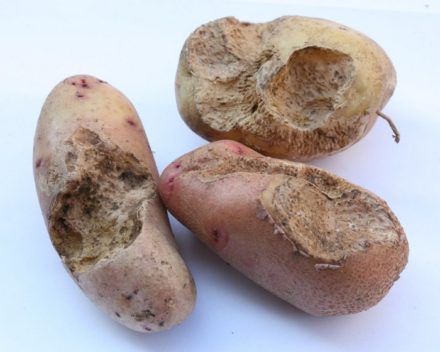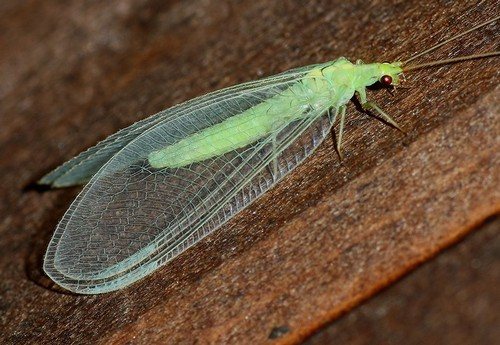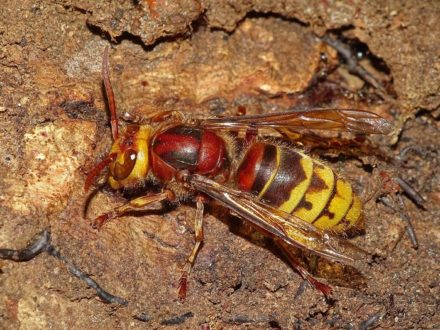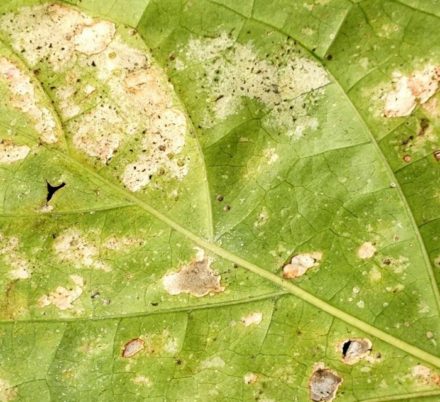The mole cricket insect is familiar to farmers firsthand. It is the worst enemy of the vegetable garden and garden, which impoverishes the land and ruins the harvest. Let's get to know the characteristics of the insect and methods of dealing with it.
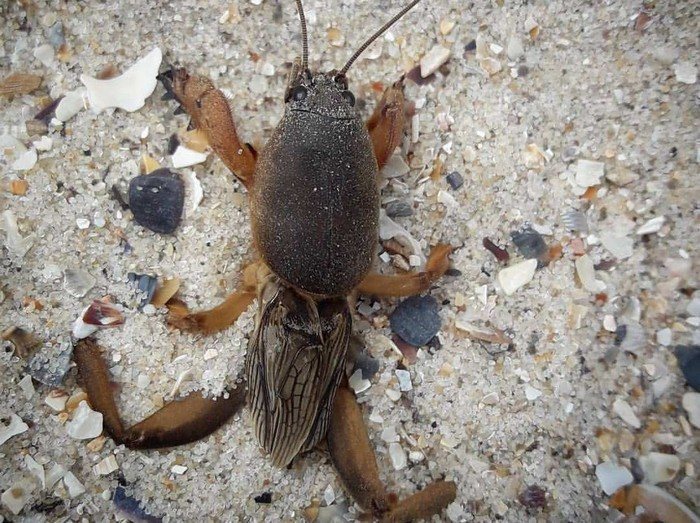
- Description of the insect
- Species
- Distribution and habitat
- What they eat
- How they reproduce
- How they overwinter
- Signs of a mole cricket on the site
- Reasons for the appearance of a mole cricket on the site
- What crops are affected by the pest
- Preventive measures
- How to get rid of a mole cricket
- 16 folk remedies for mole crickets
- 8 chemical preparations for mole crickets
- 3 biological remedies for mole crickets
- Agrotechnical measures
- Tips and recommendations
- Traps
- Dung
- Glass
- Honey
- Beer
- Ultrasonic devices
- Natural enemies
- Is there any benefit
- Is it dangerous for humans
Description of the insect
The pest received the name mole cricket due to its resemblance to a brown bear, its coloring and clawed paws. The second name is cabbage mole. The pest was given this name because of its love for cabbage seedlings. And the nickname mole-cricket did not appear for nothing. Its structure and the sounds it makes resemble a cricket. And it digs the ground with its front paws like a mole.
Description:
- Class - large invertebrate arthropods. Order - jumping neoptera.
- Body length 3.5-5 cm. In a mature individual 7.5 cm. Sometimes there are giant ones, up to 15 cm in size.
- The color of the soft abdomen is greenish, the top of the body is dark brown.
- Round eyes are located on the cephalothorax.
- The jaws protrude forward.
- The elytra are wide and shortened. From under them you can see wings, soft and thin, which stretch along the back.
- The pronotum accounts for a third of the length of the body. The section begins with the head.
- The head with two eyes and shortened antennae is covered with a chitinous layer like a helmet.
Mole crickets fly and swim. Some species move over distances of up to 8 km. Flights are made only at night in search of new habitats. Lifting height no more than 5 m.
Adaptability Traits:
- Digging technology has achieved good development. With front claws resembling shovels, pests have adapted to digging holes and passages.
- The legs of a flat structure successfully cut off young shoots, and powerful jaws eat away the cavity of root crops.
- The type of mouthpart is gnawing, which makes it possible to destroy the roots of useful plants.
- A powerful and hard chest shell allows the insect to hide its head under it at the right time.
Although the mole cricket looks intimidating, it is shy. During the day it rarely appears on the ground surface. Active life and the search for food begin at night, when the plants rest.
Kinds
There are 110 varieties of mole crickets in nature, which are similar in appearance, lifestyle, and taste benefits. But they differ in the set of chromosomes.
Common mole cricket:
- sizes 3.5–5.0 cm;
- abdomen olive or yellowish with small hairs;
- body dark brown;
- the back and head are black and gray.
The main habitats are Europe (except Scandinavian countries), North Africa, the Middle East, Iran, Kazakhstan, Transcaucasia, the Russian Federation, and other territories.
African mole cricket:
- dimensions 2.0–3.5 cm;
- abdomen light yellow;
- the body is dark yellow with small antennae.
Places of residence: Russian Federation (Far East), Australia, New Zealand, Ceylon and Madagascar, Korea, Central Asia, and other lands.
Single-thorn bear:
- dimensions 3.8–4.5 cm;
- narrow body;
- fore wings without pronounced veins;
- body color from brown to brown-yellow.
Places of residence: the south of Moldova and Ukraine, Crimea, Armenia, Georgia, Iran, China and other southern territories.
Single-thorned species prefer saline soils and wet salt marshes. They eat everything that is found in summer cottages and vegetable gardens.
The Far Eastern one is close in appearance to the common one. Settles in China, Japan, Vietnam, in the Russian Federation on Sakhalin.
Distribution and habitat
The geography of distribution of cabbage grass is significant. Mole crickets inhabit all continents. The exception is Antarctica.
Mole crickets choose moist soils enriched with humus, river floodplains, as well as places with reservoirs and high groundwater. They are attracted to sandy and clayey soils and wetlands. But hot and dry areas are avoided.
What do they eat?
Mole crickets resemble locusts. Walking through vegetable gardens, orchards, fields and meadows, it cleans up everything in its path. They destroy roots, seeds, shoots and stems of cultivated plants. And what remains is eaten by the larvae.
But not only cultivated plants are of interest to the cabbage plant. They eat small insects, weeds and even the larvae of their fellow creatures.
Pests are very greedy. Even after saturation, they continue to gnaw crops and spoil fruits and vegetables. It is estimated that one individual gnaws up to 15 plants per day.
Gardeners claim that their favorite foods are corn, beets, and potatoes.But it is not without reason that the people called the insect cabbage fly. The mole cricket cannot resist cabbage. Roots, young shoots, and heads of cabbage are eaten.
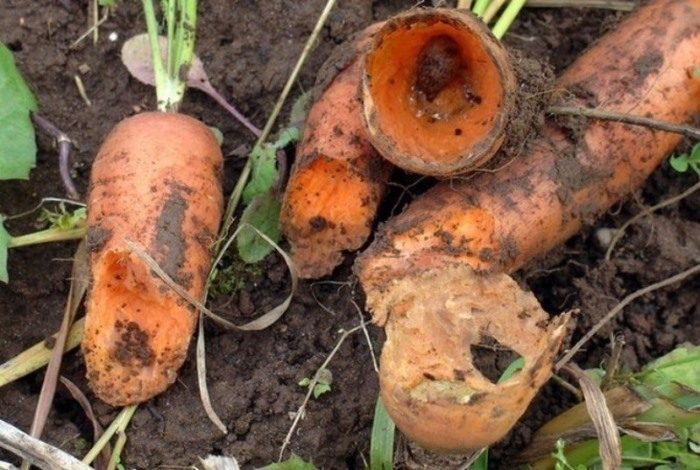
How do they reproduce?
After overwintering underground, mole crickets crawl to the surface and prepare to reproduce. The first thing is to choose a mate. Together they return to the hole, where mating occurs.
While waiting for the larvae, the male and female prepare the home. Having descended 5–6 cm underground, they dig tunnels and arrange nests in the shape of a ball. The female lays up to 300-600 eggs in them.
The eggs are oblong, about 2 cm long, yellowish-gray in color. Externally they resemble millet grains. After 20 days, gray larvae with three pairs of legs, similar to adult mole crickets, emerge from the eggs.
After the birth of the offspring, the females take care of and protect the insects for another 20–30 days, but after this time they die. And the larvae, which have turned into adult insects, begin to live independently. Mole crickets live 3–5 years.
How do they winter
Burrows made in humus, soil, and manure help mole crickets survive the winter. Adult insects burrow to a depth of 1.0–1.2 m, and young insects only 20–30 cm. In the spring, at a temperature of 15° C, they crawl to the surface.
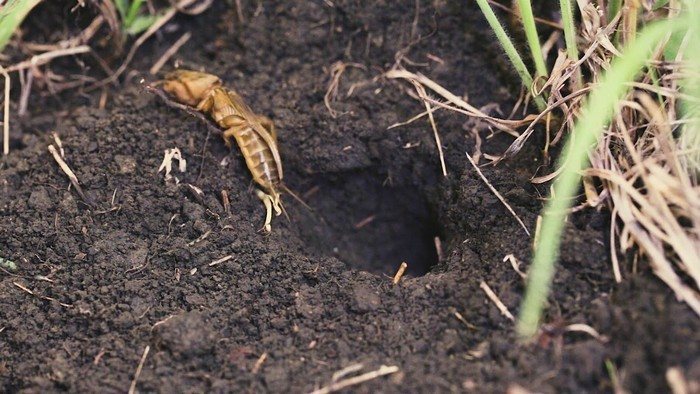
Signs of a mole cricket on the site
Even attentive gardeners often do not notice that mole crickets have appeared on the site. Meanwhile, pests leave obvious traces of their presence.
What signs indicate their presence on the site:
- unexpected death of plantings;
- drying of young growth, which is easily removed from the soil;
- formation of rhizome damage in adult plants;
- holes on roots and fruits;
- the appearance of holes with a diameter of up to 2 cm near the plants with passages leading from them;
- detection of small earthen mounds and open holes with clearly defined edges. If you pry the ground with a shovel in this place, you may come across a mole cricket nest.
- in May–June (mating season) they begin to chirp, attracting females. The louder the male is, the more females come running to him. By chirping, gardeners judge the appearance of harmful insects.
Soon after the first signs appear, the insects crawl out. Mole crickets lead a closed lifestyle, but in search of food they come out of their burrows.
Reasons for the appearance of mole crickets on the site
There are several reasons for the appearance of pests on an existing site. Each is explained by the way of life of insects.
Reasons for appearance:
- In well-kept areas with fertile soil you can always find delicious food.
- In loose, fertilized soil it is easier to make passages and dig holes.
- They are attracted to dung heaps, where it is warm and satisfying. It’s good to spend the winter in them without worrying about food.
Therefore, although mole crickets do well in abandoned dachas, wastelands, and weed thickets, they prefer well-groomed areas with fertile soil.
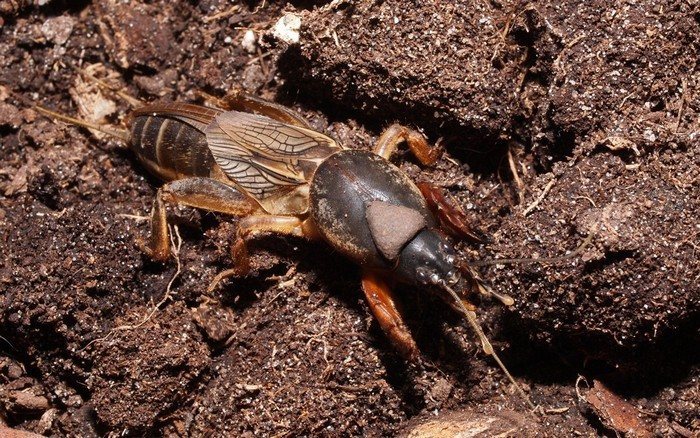
What crops are affected by the pest?
The mole cricket is an omnivorous insect. Damages above-ground and underground parts of crops. The exception is the roots of trees and shrubs. Destroys tubers and sown seeds, seedlings of berry and ornamental plants, vegetables, fruits and berries.
The following crops are often affected:
- young potatoes;
- White cabbage;
- radish;
- fodder and sugar beets;
- beans;
- carrot;
- tomatoes;
- radish;
- pumpkin;
- Bulgarian pepper;
- eggplant;
- parsley;
- melon crops.
Among the berries, strawberries, wild strawberries, and grapes are preferred.Fallen ripe fruits of pear, apple and plum trees also attract the attention of the mole cricket. The pest affects wheat, rye, barley and other grain crops. In forest areas, young spruce, pine, and oak trees are attacked.
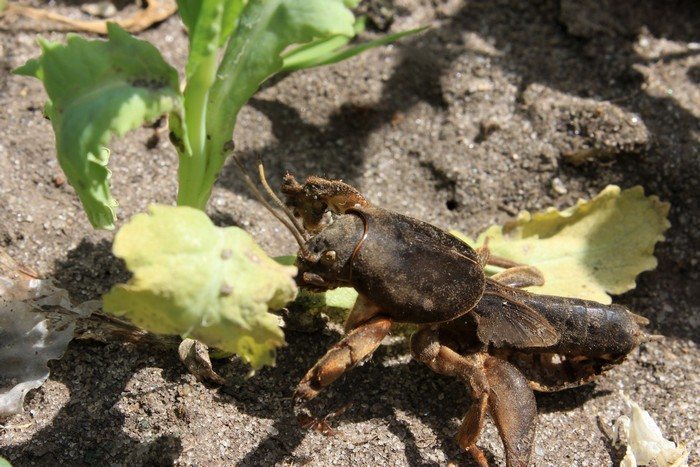
Preventive measures
Even if mole crickets are not visible on the site, there is no guarantee that they will not appear in the near future. Pests come from a neighboring garden, appear on the site along with manure, fly through the air, and in other ways. Simple preventive measures will help preserve the harvest.
Preventive measures:
- When selecting fertilizers, fresh manure is excluded. The best choice is biennial manure. Then the appearance of pests will become impossible.
- Everyone knows the role of green manure in plant cultivation. These are not only green fertilizers. Green manure protects cultivated plants from insects. Therefore, it is useful to plant them to preserve the harvest. It is better to plant rye or marigolds against mole crickets.
- If the autumn garden is not put in order, plant remains are not burned or buried, mole crickets and larvae choose old fruits and leaves for wintering. And in the spring they fill the area. Therefore, autumn work in the garden is the best protection.
- Agrotechnical activities, such as weeding and digging, play an important role in the battle with mole crickets for the harvest. By pulling out weeds, a person deprives the insect of food. In addition, they do not return to the ground, where tunnels and burrows have been destroyed by digging.
- Crop rotation prevents diseases and the spread of pests. Planting plants constantly in one place provokes the accumulation of old diseases, and at the same time mole cricket larvae.
- Insects settle only in acidic soils. Therefore, annual soil deoxidation reduces the likelihood of site contamination.Lime or dolomite flour is used for deoxidation.
- Since the mole cricket likes warm soil, gardeners reduce the soil temperature. To do this, the soil is mulched with light material. Straw, sawdust, and pine needles are suitable. In addition to lowering the temperature, the smell of mulch also repels the pest.
For prevention, garden crops are planted near the beds or along the perimeter, which repel the pest with a specific smell. And experienced gardeners do not recommend fresh manure, where larvae and adult insects settle. And they advise using humus or compost.
How to get rid of the mole cricket
If prevention has not yielded results and the mole crickets have settled on the site, folk methods of control are used. If the means do not help, they turn to chemistry.
16 folk remedies for mole crickets
The advantage of these methods is that they contain substances that are safe for both humans and plants.
- Description of the products:
- Soap solution. Combine the liquid with soap shavings, add vegetable oil in a ratio of 1:10. Pour a liter of liquid into the hole. Soon, a mole cricket will appear on the surface. All that remains is to catch and crush the pest.
- Eggshell. Crush the dried eggshell. Add vegetable oil with a scent. Place the treat in the planting holes or furrows. Then plant the seedlings or seeds. Mole crickets will not resist such a snack, but the sharp pieces of shell will be fatal to them. The remaining shell will turn into fertilizer.
- Oil solution. Pour water into the hole, add 1-2 tbsp. of oil, then water again. Making its way to the exit, the pest swallows a viscous composition that atrophies the respiratory tract. The body of a dead insect will appear on the surface.
- Bread and matches.For deoxidation, use lime or dolomite flour.
- Since the mole cricket loves warm soil, gardeners reduce the soil temperature. To do this, mulch the soil with light material. Straw, sawdust, pine needles will do. In addition to lowering the temperature, the smell of mulch also repels the pest.
- For prevention purposes, garden crops are planted near the beds or along the perimeter, which repel the pest with a specific smell. And experienced gardeners do not recommend fresh manure, where larvae and adult insects settle. It is recommended to use humus or compost.
- How to get rid of a mole cricket
- If prevention does not produce results and mole crickets settle on the site, traditional methods of control are used. If the remedies don’t help, move on to chemistry.
- 16 folk remedies for mole crickets
- The advantage of the methods is that they contain substances that are safe for both humans and plants.
- Description of funds:
- Soap solution. Combine the liquid with soap shavings, add vegetable oil in a ratio of 1:10. A liter of liquid is poured into the mink. Soon a mole cricket will appear on the surface. All that remains is to catch and crush the pest.
Oil solution. Water is poured into the mink, 1-2 tbsp is introduced. l. oil, then water again. Making its way to the exit, the pest swallows a viscous composition that atrophies the respiratory tract. The body of an already dead insect will appear on the surface.
Bread and matches.A piece of crustless bread is moistened with water and kneaded until sticky. Rolling balls. Match heads are inserted inside the balls, where the soaked sulfur contaminates the bread bait. All that remains is to scatter the balls around the area and next to the mink, then wait for the result.
Ammonia. Dilute 3 tbsp in 10 liters of water. l. ammonia. Water the soil, being careful not to get it on the plants. The smell of ammonia will force mole crickets to look for a new shelter. When preparing the poison, the proportions are observed so as not to oversaturate the soil with nitrogen.
Iodine. The beds with root crops are watered with iodine solution. 15 drops of the drug are diluted in a 10-liter bucket of water. The smell causes insects to scatter and never return. This product is used to treat greenhouses and open areas.
- Kerosene in water. 150 g of kerosene are diluted in 10 liters of water. Pour the composition into holes and passages. As a result, the mole cricket's instant death follows.
- Kerosene with sand. A bucket of sand is mixed with a tablespoon of kerosene. Scattered in the garden along the paths. Sprinkle the beds and the ground around the holes.
- Onion peel. Pour 800 g of husk into a 10-liter bucket of hot water (not boiling water). The composition is sprayed over the area, not leaving unattended areas where pests accumulate. Or leave a bucket of solution on the site. In both cases, the onion aroma will force the bear to leave the territory.
- Garlic. Chopped or crushed garlic is placed in the seed holes. The pungent odor will repel pests.
- Chicken droppings. To prepare the product, add 2 kg of chicken manure to a bucket of water and leave for 24 hours. Add water to the resulting mixture at a ratio of 1:5 and water the beds.
- Manure. In the fall, they dig a hole near the garden, with a length, width and height of 50 cm, then fill it with manure.Mole crickets will certainly settle in manure for the winter. When frosts occur below -3°C, a hole is dug out and manure is scattered around the area. Pests freeze and die.
- Jars with liquid. At the beginning of the spring season, holes are made near the beds into which jars of water, kvass or beer are placed. The neck of the jar is left at ground level. At night, mole crickets accumulate there.
- A piece of iron. The method is used in the spring, before digging up the site. Although the method works in summer too. On a sunny day, small pieces of iron are scattered around the area. Under them, mole crickets accumulate, having come out to bask. At this point you can get rid of pests.
Protective rings. Trenches 20–50 cm deep are dug around greenhouses or beds. Crushed shells, ash, sawdust, broken glass, and fragments of bricks are poured into them. Spray kerosene on top. This prevents access for pests.
A mole cricket attacks potatoes: how to understand that it is one and protect the plant from it
Publicly available means of fighting mole crickets will give results if neighbors in the garden get involved. Otherwise, it will not be possible to remove the insect.
8 chemical treatments for mole crickets
There are quite a lot of chemicals, and some help in the fight against mole crickets and other pests.
- Effective chemistry against insects:
- Medvetox. Available in granular form. The drug is non-toxic and does not harm soil microflora. The granules are buried 3-5 cm in the grooves between the beds. After 4 hours the drug begins to act.Protects against pests for 14 days.
- Anti-Medvedka. The drug is insecticidal. Release form: microgranules. Protects vegetables and flowers from mole crickets and other insects. When planting and sowing crops, granules are scattered between the beds.
Medvecide. Powerful bait for killing various types of insects. Harmless to people and animals. Available in granule form. The beards, 2.5-3 cm deep, are dug at a distance of 0.8-1.0 m from each other. Each one contains 5 to 10 granules. The bait is valid for 20 days.
Rembek. Granular insecticide with a pungent odor. Does not pose a threat to the environment. The bait is distributed among minks and dug passages. One 360 g packet of product is enough to treat 15 acres of land.
Phenaxin plus. Available in the form of granules with a smell that attracts mole crickets. But the main danger is the neuroparalytic effect that the drug has. The bait is scattered on the beds, around trees, in manure and other fertilizers. One pack of granules is enough for 10 square meters. m area. The product is valid for 20 days.
Calcium carbide. The product is used to fill minks, holes, passages. After rain or watering, a chemical reaction begins, releasing toxic gas. None of the pests will be saved.
Bio-discharge. A broad-spectrum drug. The insecticide is available in powder form and is used diluted. The product package is diluted in 10 liters of water. Use 0.5-1.0 liters of solution per well. The product attracts mole crickets as it releases an odorous substance. And then it neutralizes it. It is possible to add dry product into the hole.
Grizzly. Attracts insects by smell. Destroys at any stage of development. Fill the holes along the bed with granules and sprinkle with soil.Plants will be protected for up to three weeks.
How to deal with hornets at the dacha, in the house and on the site
3 biological remedies for mole crickets
Experienced gardeners see biological products as an alternative to chemicals.
Since beneficial insects live in the garden, you need to choose biological products with care so as not to cause harm. And at the same time, protect the area from the presence of the mole cricket.
Popular biological products:
"Boverin". The product contains fungal spores. Penetrating into the body of the mole cricket, the spores germinate and ultimately cause death. The product is more effective in controlling greenhouse pests.
"Nemabact." Contains bacteria and predatory nematodes. The drug infects the insect with bacteria, due to which the insides decompose and the pest dies. The drug is effective, but capricious. If storage conditions are not met, it loses its properties. Stored in the refrigerator. Effective in garden beds at temperatures up to 25°C.
"Anthony F." The drug has the same range of action as Nemabact. Differs in the type of nematode.
If the production technology of biological products is violated and the shelf life has expired, quality is lost.
Agrotechnical measures
Carrying out agricultural work is unlikely to help completely eradicate the mole cricket. But when carried out in combination with other methods, extermination of the pest is possible.
Tips and tricks
After collecting the last harvest, put the area in order. Clear away debris, leaves, and branches. Cleaning will allow you to notice pests and their holes.
Dig the area with a spade twice, in the fall and in the spring. It will be possible to destroy burrows and nests.And catch the scattering mole crickets with traps.
Treat seed and roots of seedlings before planting. Inspect the soil from time to time, remove weeds, and carry out preventive measures.
Autumn pest control in the greenhouse so as not to be left without a harvest in the new season
Traps
Having studied the taste and aromatic preferences of the cabbage moth, gardeners have developed traps for the mole cricket. Some of them are interesting.
Dung
- The mole cricket is attracted by the smell of manure. Gardeners lay out piles around the site. Very often pests settle in them and lay eggs here.
- Glass
- A liter jar is filled with honey, mashed potatoes or sunflower oil. Buried vertically in the ground in places where there are a lot of pests. I cover the jar with straw, leaves, and dry branches. A mole cricket that has fallen into a trap is unlikely to be able to get out.
- Honey
- It is good to set such traps in late summer - early autumn. During this period, pests are preoccupied with preparing for winter.
- The jar coated with honey is covered with a sheet of plywood or tin and insulated on all sides with straw. Cabbage damsels happily climb into the fragrant, warm, but deadly trap.
Beer houses
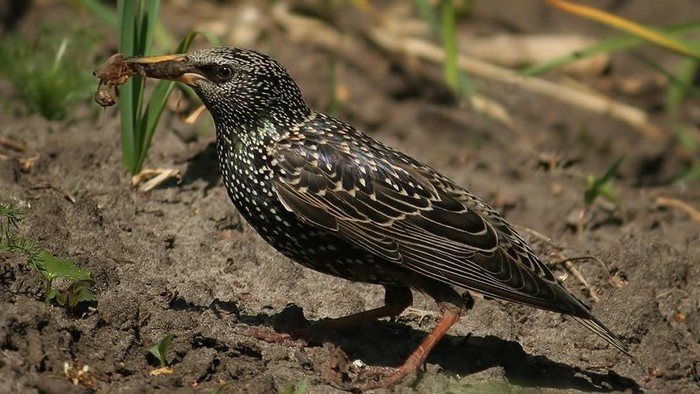
Since cabbage plants like malt, gardeners bury an open bottle of beer in the ground. Place the container at an angle to make it easier for the bear to get inside.
Ultrasonic devices
Previously, these devices used to scare away rodents, but, as it turned out later, some successfully deal with mole crickets. These are “Antikrot”, “Tornado” and “Ecosniper”.
To achieve the effect, one device per area is not enough. It was calculated that at least one device will be required per 1 are (one hundred square meters). Externally, the device resembles a capsule that is stuck into the ground.
There are about 15 varieties of ultrasonic devices. They differ in name, price, range, duration of operation. Each device comes with an instruction manual.
Natural enemies
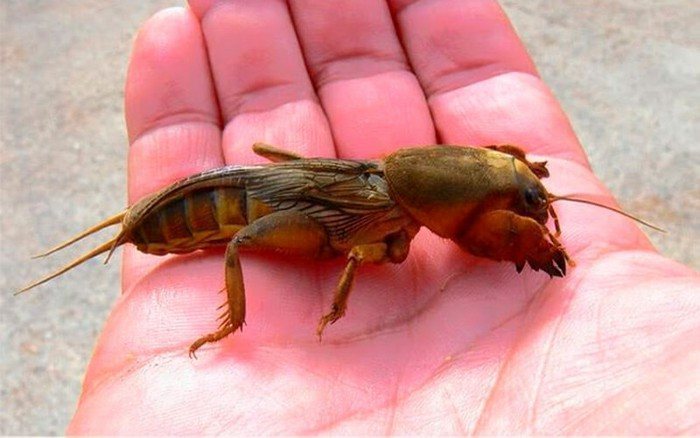
When fighting mole crickets, one should not forget that humans have natural helpers in this difficult task.


